Quick Look
Grade Level: 5 (3-5)
Time Required: 45 minutes
Lesson Dependency: None
Subject Areas: Earth and Space
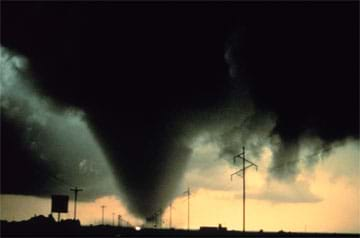
Summary
Students learn about tornadoes - their basic characteristics, damage and occurrence. Students are introduced to the ways that engineers consider strong winds, specifically tornadoes, in their design of structures. Also, students learn how tornadoes are rated, and learn some basics of tornado safety.Engineering Connection
Understanding the science of natural phenomena enables engineers to design and build strong structures to withstand natural disasters such as tornadoes. By combining their expertise in inventing measurement and data gathering tools with their ability to analyze and learn from past failures, engineers continue to improve structural designs, advance warning systems and emergency procedures for human safety. This same process of gathering and analyzing data to better understand problems and formulate solutions is used in all engineering disciplines.
Learning Objectives
After this lesson, students should be able to:
- Understand how engineers design and build structures to withstand tornado damage.
- Describe tornadoes, how they are measured and how they are formed.
- Understand how the wind and tornadoes affects humans.
- Describe some basics of tornado safety.
Educational Standards
Each TeachEngineering lesson or activity is correlated to one or more K-12 science,
technology, engineering or math (STEM) educational standards.
All 100,000+ K-12 STEM standards covered in TeachEngineering are collected, maintained and packaged by the Achievement Standards Network (ASN),
a project of D2L (www.achievementstandards.org).
In the ASN, standards are hierarchically structured: first by source; e.g., by state; within source by type; e.g., science or mathematics;
within type by subtype, then by grade, etc.
Each TeachEngineering lesson or activity is correlated to one or more K-12 science, technology, engineering or math (STEM) educational standards.
All 100,000+ K-12 STEM standards covered in TeachEngineering are collected, maintained and packaged by the Achievement Standards Network (ASN), a project of D2L (www.achievementstandards.org).
In the ASN, standards are hierarchically structured: first by source; e.g., by state; within source by type; e.g., science or mathematics; within type by subtype, then by grade, etc.
NGSS: Next Generation Science Standards - Science
-
A variety of hazards result from natural processes (e.g., earthquakes, tsunamis, volcanic eruptions). Humans cannot eliminate the hazards but can take steps to reduce their impacts.
(Grade 4)
More Details
Do you agree with this alignment?
-
Science explanations describe the mechanisms for natural events.
(Grade 5)
More Details
Do you agree with this alignment?
International Technology and Engineering Educators Association - Technology
-
Students will develop an understanding of the attributes of design.
(Grades
K -
12)
More Details
Do you agree with this alignment?
-
Students will develop an understanding of engineering design.
(Grades
K -
12)
More Details
Do you agree with this alignment?
-
Structures need to be maintained.
(Grades
3 -
5)
More Details
Do you agree with this alignment?
State Standards
Colorado - Science
-
Develop and communicate an evidence based scientific explanation around one or more factors that change Earth's surface
(Grade
5)
More Details
Do you agree with this alignment?
-
Develop and communicate an evidence-based scientific explanation for changes in weather conditions
(Grade
5)
More Details
Do you agree with this alignment?
Introduction/Motivation
Dorothy went on a ride in a tornado. It was so powerful that it took her to the Land of Oz. Sound familiar? In reality, a person who gets into the middle of tornado may not survive its powerful force. Tornadoes can produce winds exceeding 250 mph and can cause hundreds of deaths and injuries. In addition, tornadoes cause millions of dollars in damage every year. In fact, tornados can move objects up to 100 miles from where they started.
A tornado is a fast rotating column of air that reaches down from a thunderstorm to the ground. They occur under many different conditions, and usually (but not always) are associated with a thunderstorm. Tornadoes appear almost transparent until they pick up dust and debris or a cloud forms within the funnel — the main, center portion of the tornado. The United States, on average, experiences about 1,000 tornadoes a year in all 50 states. They can range from a few feet in diameter to more than a mile wide and can travel short distances to many miles (up to 50 miles on the ground!), with a forward speed of up to 70 miles per hour. Most tornadoes last only 1-10 minutes and have wind speeds of less than 110 miles per hour. These tornadoes do not often kill people. However, some of the strongest tornadoes can stay on the ground for an hour and cause severe damage. They most often occur east of the Rocky Mountains, in the spring and summer, and in the afternoon and evening.
We measure tornadoes by looking at their speed, diameter and how much damage they leave behind. There is only one scale that currently exists for rating tornadoes — the Fujita Tornado Damage Scale, or F-Scale. It was created in 1971 by Dr. T. Theodore Fujita and compares wind speed to damage. It is not a scientifically proven scale but is one way to describe what might happen during a tornado. Students can conduct investigations towards their regions history of tornados and the damage caused by such natural disasters with the associated activities A Tornado in My State? and Tornado Damage!
There is no area (trees, lakes, rivers or mountains) that is safe from a tornado, but there are places safer than others to be during a tornado. The best place to take shelter is a sturdy, reinforced building, preferably in the basement level. In parts of the country that have tremendous tornado activity, homes are built with storm cellars (a small room under the ground where people can safely "ride out" a tornado). If basements and storm cellars are not available, the next best place to be is in an interior room without windows. Engineers work very hard to design and build reinforced buildings, especially in areas that are known to have heavy tornado activity. (Show students Figures 2, 3, and 4. Explain that these are examples of engineering designs that help to increase safety in the event of a tornado. Together, these figures show different elements of tornado resistant structures.)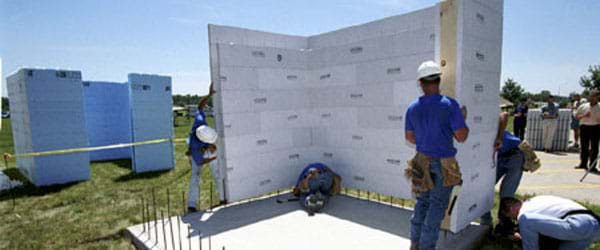
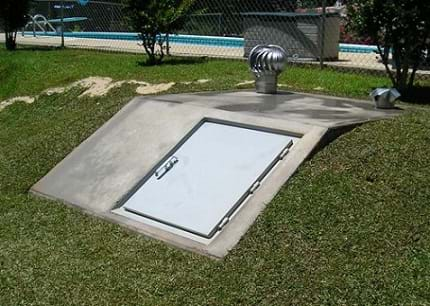
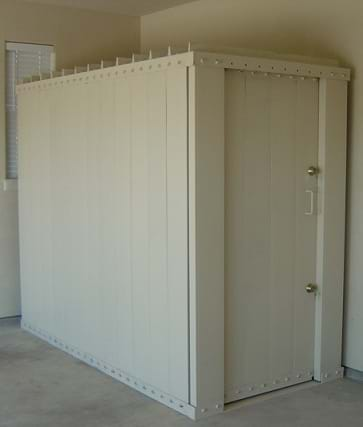
Engineers also design better advance warning systems for tornadoes and hurricanes.
Lesson Background and Concepts for Teachers
Tornadoes are normally associated with severe thunderstorms. One theory about their formation is that warm air from the Gulf of Mexico and cold air from the Rocky Mountains converge and form a sandwich layer of warm and cold air. When a warm moist layer of air gets trapped beneath a stable layer of cold dry air, it is called an inversion. When an inversion occurs over a region where two fronts have been sandwiched together, as described above, there is a high probability of thunderstorm and tornado activity. The sandwiched surface air has a tendency to rise as the air heats up throughout the day. If the upper atmosphere is disturbed — i.e., the surface air penetrates the inversion, then the warm bottom layer of the inversion enters the stable cold upper layer of the inversion, and the warm air starts to spiral. These conditions often occur in the central United States, in a region called Tornado Alley. Tornado Alley consists of Alabama, Arkansas, Florida, Georgia, Illinois, Indiana, Iowa, Kansas, Louisiana, Mississippi, Missouri, Nebraska, Oklahoma, South Dakota and Texas.
Another way that tornadoes form is from a change in wind direction and an increase in wind speed that produces a horizontal spinning effect in the lower atmosphere. Rising air from the thunderstorm pulls this rotating air from a horizontal into a vertical spin, and tornadoes are formed within this vertical area of strong rotation. Refer to the associated activity Windstorm for students to learn more about the formation of tornados.
Tornados can occur at any time, but most often, they are spotted in the afternoon and evening hours because the air is hottest in the afternoon and therefore has the greatest tendency to rise. Tornadoes also can travel in any direction, but according to NOAA, most tornados move from southwest to northeast, or west to east. Not all tornadoes follow these rules, and some change direction, or even backtrack. The length of time that tornadoes last varies from a few seconds to more than an hour, but most last less than 10 minutes. In the northern hemisphere, tornadoes rotate counterclockwise; in the southern hemisphere, they rotate clockwise. Once again, they do not always follow the established norm. In fact, some tornadoes, called anticyclones, rotate the opposite direction for their respective hemispheres. Storms can produce multivortex tornados that have two or more subvortices, or spiral masses of air, which usually last just a few seconds. Because of all the variation in tornadoes, as described above, tornadoes are very difficult to study. As a result, we know little about them.
There are two main types of tornados: rope (see Figure 5) and wedge (see Figure 6). Rope tornadoes are very long and narrow, and wedge tornadoes are huge and wide. Rope tornadoes can produce stronger winds than wedge tornadoes, and vise versa. Size does not mean strength!
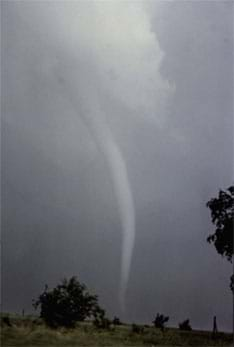
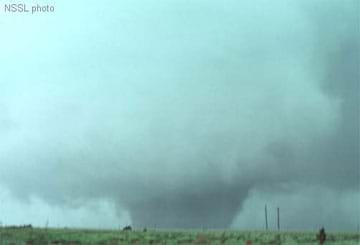
So how are tornadoes measured? Dr. T. Theodore Fujita developed a damage scale that relates the degree of damage to the intensity of the wind. Dr. Fujita's method, so aptly named the Fujita Tornado Damage Scale — or F-scale, has an error in it because different structures (buildings versus bridges versus mobile homes) can withstand wind forces differently, and according to NOAA, tornado wind speeds are still largely unknown. Students can act as engineers in the associated activity Build It Better to use what they know about tornadoes to design a house to withstand tornado-force winds. The wind speeds on the F-scale have never been scientifically tested and proven. The scale has 6 possible tornado ratings: Category F0 (light damage, <73 mpg winds) to Category F5 (incredible damage and 261-318 mph winds). Even though it has known errors, the F-scale is the only method currently used to rate tornadoes.
Associated Activities
- Windstorm - Students will investigate how a tornado forms and learn about the vortex of a tornado.
- Tornado Damage! - Students investigate the damage that tornadoes cause through the eyes of a safety engineer.
- A Tornado in My State? - Students analyze data of tornado occurrences across the U.S. to determine the mean and median.
- Build It Better! - Students imitate structural engineers and use what they know about tornadoes to design a house to withstand tornado-force winds.
Lesson Closure
Lead a discussion of why engineers are concerned about tornadoes and what they do to protect humans from tornadoes. Ask students how tornadoes can affect humans. (Answer: Tornadoes can crumple houses in seconds or blow their roofs blow off; mobile homes can blow away. They can cause hundreds of deaths and millions of dollars of damage each year.) Ask students what engineers do to protect humans from tornadoes. (Answer: They design and build better structures to withstand the high wind forces.) Ask students specifically how engineers design better structures to withstand tornados. (Answer: Examples include using strong materials such as concrete, reducing the amount and/or size of windows, and designing doors with the ability to be removed from the inside in case of debris. Additionally, engineers design structures which are built into the ground or anchored to a concrete foundation.) Also talk to students about tornado safety. Ask students what they should do if they think a tornado is coming (Answer: Seek shelter immediately.)
Vocabulary/Definitions
air masses: Large areas of air with common traits such as air pressure and temperature.
air pressure: Pressure caused by the weight of the air.
climate: Conditions of a region that includes wind conditions and temperatures.
convection: The tendency of cold, dense fluids to fall and displace warm, less dense fluids.
front: A surface that slopes in the atmosphere that separates air masses of different temperature and density.
inversion: An atmospheric condition in which the air temperature rises with increasing altitude, holding surface air down and preventing dispersion of pollutants.
jet stream: Wind flowing in the westerly direction that is upper level air.
kilometer (km): Unit of measure for length.
rope tornado: According to NOAA, tornadoes often assume a ropy, sinuous shape in their final minutes; but they can remain narrow like this during their entire life cycles.
subvortices: Vortices that offshoot from a tornado.
supercells: Large, powerful thunderstorms that sometimes produce tornadoes.
The Fujita Tornado Damage Scale: A way to measure the force of a tornado based on damage.
tornado: A rotating column of air ranging in width from a few yards to more than a mile and whirling at destructively high speeds, usually accompanied by a funnel-shaped downward extension of a cumulonimbus cloud.
tornado alley: A region located in the United States.
vortex: A spiral motion of fluid within a limited area, especially a whirling mass of water or air that sucks everything near it toward its center.
wedge tornado: Slang for a tornado that looks wider than the distance from the ground to cloud base.
Assessment
Pre-Lesson Assessment
Discussion Questions: Solicit, integrate, and summarize student responses.
- What do you know about tornados?
- Have you ever seen or been in a tornado?
- How are tornados formed?
Post-Introduction Assessment
Voting: Ask a true/false question and have students vote by holding thumbs up for true and thumbs down for false. Count the number of true and false and write the number on the board. Give the right answer.
- Tornados only occur in the Mid-western United States. (Answer: False, tornados strike in all 50 states.)
- Tornados can produce winds exceeding 450 miles per hour. (False, the strongest tornado recorded is 250 mph.)
- Tornados can move objects 100 miles away from where they started. (Answer: True)
- Tornadoes appear almost transparent until they pick up dust and debris or a cloud forms within the funnel. (Answer: True)
- Most tornadoes last over 30 minutes and have wind speeds of more than 200 miles per hour. (Answer: False, most tornadoes only last 1-10 minutes and have wind speeds of less than 110 miles per hour.)
- Tornadoes can kill people. (Answer: True, on average, tornadoes kill 80 people a year, but mostly from flying or falling debris.)
- It is best to be in a mobile home during a tornado. (Answer: False, it is best to be inside a sturdy, reinforced building, preferably in the basement level.)
- A wooden shed is safer than a concrete shed during a tornado. (Answer: False, concrete is stronger and better suited for the high winds of a tornado.)
- Being underground during a tornado is safer than being in the second floor of a house. (Answer: True, being underground, or even on the ground floor of a house, is safer than the second floor.)
- Tornadoes can blow roofs off houses. (Answer: True)
- The Fujita Tornado Damage Scale, or F-Scale, is one scale for rating tornadoes. (Answer: True, it is the only scale that currently exists for rating tornadoes.)
Solutions: Ask students to compare multiple solutions to reduce the impacts of tornados.
Lesson Summary Assessment
Inside/Outside Circle: Have the students stand in two circles such that each student has a partner. Three people may work together if necessary. The outside circle faces in and the inside circle faces out. Ask the students a question. Both members of each pair think about the question and discuss their answers. If they cannot agree on an answer, they can consult with another pair. Call for responses from the inside or outside circle or the class as a whole.
- What is a tornado? (Answer: A tornado is a fast rotating column of air that reaches from a thunderstorm to the ground.)
- Where are safe places to be during a tornado? (Answer: Basements, storm cellars, interior rooms without windows.)
- How fast do tornadoes rotate? (Answer: They can rotate up to 250 mph.)
- Where do tornadoes frequently occur? (Answer: Tornado Alley, east of the Rocky Mountains)
- How long do most tornadoes last? (Answer: Most tornadoes only last 1-10 minutes.)
- What scale do we use to describe tornadoes? (Answer: There is only one scale for rating tornadoes, the Fujita Tornado Damage Scale, or F-Scale.)
- What time of year do most tornadoes occur? (Answer: They most often occur in the spring and summer and in the afternoon and evening hours.)
- What can engineers do to design more tornado resistant homes? (Answer: Engineers can build a safe room on the first floor of a house or underground in a basement, with a concrete foundation, concrete walls, a special door and no windows.)
Word Web: Make a word web on the board, with the topic in the center (tornadoes), and supporting terms (e.g., damage, location, formation, types, safety) as branches off the center, around the outside. Have the class brainstorm ways to relate the terms to the main topic. Add the student ideas under each component on the web.
Lesson Extension Activities
There is an abundance of information available on the Internet about tornadoes from reliable sources (www.spc.noaa.gov, for instance).
Subscribe
Get the inside scoop on all things TeachEngineering such as new site features, curriculum updates, video releases, and more by signing up for our newsletter!More Curriculum Like This

In this activity, students learn about how tornadoes are formed and what they look like. By creating a water vortex in a soda bottle, they get a first-hand look at tornadoes.

In this activity, students learn about how tornadoes are formed and what they look like. By creating a water vortex in a soda bottle, they get a first-hand look at tornadoes.

Students are introduced to natural disasters and learn the difference between natural hazards and natural disasters.

Students learn that wind and storms can form at the boundaries of interacting high and low pressure air masses. They learn the distinguishing features of the four main types of weather fronts (warm fronts, cold fronts, stationary fronts and occluded fronts) and how these fronts are depicted on a sur...
References
Houghton Mifflin Company. The American Heritage® Dictionary of the English Language, Fourth Edition, New York: Houghton Mifflin Company, 2000.
Copyright
© 2004 by Regents of the University of Colorado.Contributors
Jessica Todd; Melissa Straten; Malinda Schaefer Zarske; Janet YowellSupporting Program
Integrated Teaching and Learning Program, College of Engineering, University of Colorado BoulderAcknowledgements
The contents of this digital library curriculum were developed under a grant from the Fund for the Improvement of Postsecondary Education (FIPSE), U.S. Department of Education and National Science Foundation GK-12 grant no. 0338326. However, these contents do not necessarily represent the policies of the Department of Education or National Science Foundation, and you should not assume endorsement by the federal government.
Last modified: January 7, 2021









User Comments & Tips